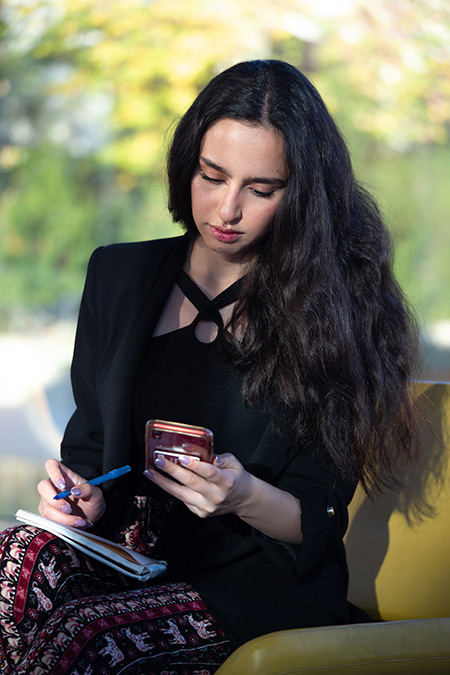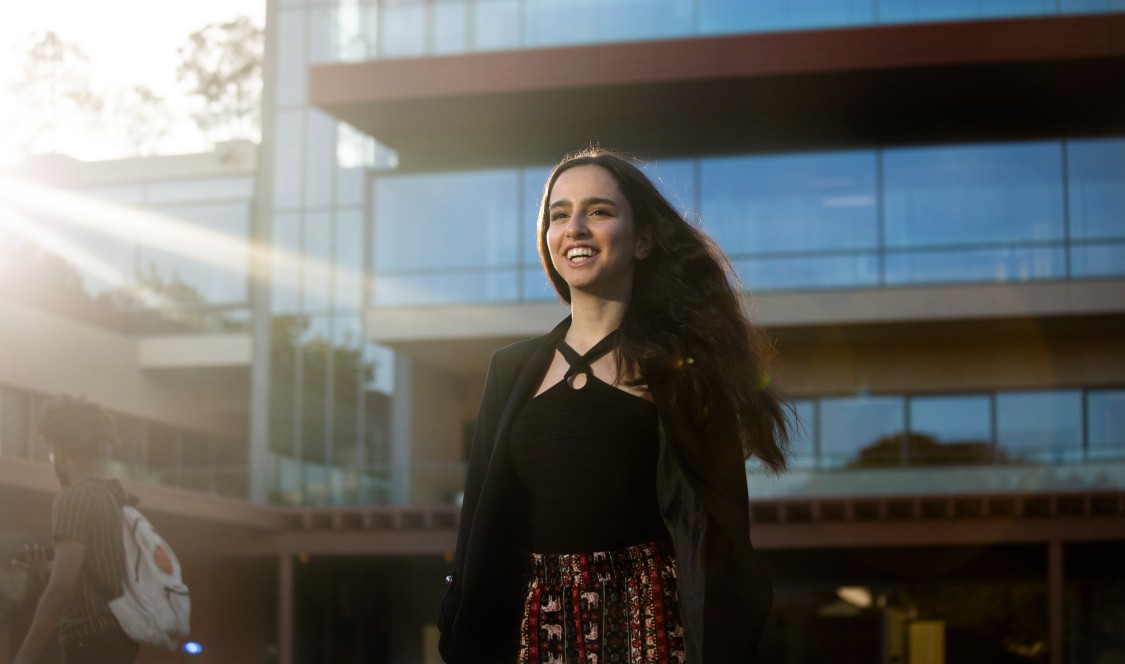About the Kurds
Worldwide, some 35 million Kurdish people inhabit more than 50 countries. Denied a nation state, their ancestral homes cut across Turkey, Iran, Iraq, and Syria. An autonomous Iraqi Kurdistan emerged after the 1991 Gulf War. Beginning in 2011 with the Syrian Civil War, a second Kurdish homeland took shape in northeastern Syria, near the Turkish border. The recent American retreat from Rojava dealt a blow to Syrian Kurds in their bid for independence.
Yara Ismael ’22 thought she might be the only Kurdish student at CMC. Then one day, she spotted recent graduate Sherin Zadah ’17 in a Facebook group.
A Kurdish flag proudly waved on her profile page.
The two young women bonded immediately. In less than a year, they have become the face of Kurdish-American activism, sparking a fledgling movement. Their voices rang out over BBC, NPR, and local radio and televisions stations. Their message has appeared in the San Diego Tribune and The Huffington Post. In late November, their powerful op-ed, “Heartbreak for Kurdish Americans,” ran in the Wall Street Journal.
Zadah and Ismael sprang to national prominence in the wake of President Donald Trump’s October announcement that the United States would withdraw its forces from Syria, clearing the way for a Turkish assault on the Rojava region and the displacement of Kurdish fighters who had been vital allies in the war against ISIS.
The two women wasted no time mobilizing for action. They circulated fliers on social media that drew hundreds of protestors to demonstrations they’d organized outside the federal building in downtown San Diego and the Turkish consulate in Los Angeles. They stood confidently in front of TV cameras.
“We feel betrayed,” Zadah told a local San Diego reporter. She has given some 50 interviews since then, in English and Kurdish. Ismael’s language toolkit also includes Arabic, Turkish, and French.
Reaching the masses
Their voices filled a vacuum. Despite media coverage of the Rojava crisis, “the Kurdish-American perspective was missing,” said Ismael, an international relations major from La Habra, Calif. “It was important for us to make sure it wasn’t just experts talking about this. And partly it was our community’s fault, because the press doesn’t really know who to go to or what to ask.”
As the Rojava crisis unfolded, Ismael and Zadah also turned themselves into lobbyists. They called each member of the House Foreign Affairs Committee to ask where they stood in their support for the Kurds. Ismael flew to Washington, D.C. to meet face-to-face with the committee’s foreign policy aides.
When the Senate prepared to vote on a bill imposing sanctions on Turkey for its incursion, the two women set up a phone bank at CMC and recruited volunteers to convince representatives to vote “yes.” Most notably, their efforts had begun to reach everyday Americans—an important step since Kurdish immigrants alone can be hard to engage.
The Kurdish-American community, Ismael explained, is very localized. Though Kurds worldwide number around 35 million, only 40,000 live in the United States, mostly clustered in Nashville, Dallas, and San Diego. Few national-level organizations exist, and those that do tend to emphasize Kurdish language and culture, not politics.
“Even the protests we organized—we had more non-Kurds show up than Kurds,” Ismael said.
Kurds largely arrived in America in three waves—first, in the 1970s; again, after the 1991 Gulf War; and in recent years, fleeing chaos in Iraq and Syria. War-wearied, older Kurdish-Americans avoid rocking the boat, Ismael said.
“They’ve internalized that any kind of activism is bad,” she said. Instead, it has fallen to younger Kurdish-Americans to give voice to the painful history of the Kurdish people.
A history of hardships

Yara Ismael ’22
As Ismael and Zadah became sought-after media commentators and political activists, they also had to juggle other obligations.
Zadah, who graduated with a degree in political science and government, works remotely in San Diego for a China-based educational consulting group. She is currently applying to graduate schools in international law and security studies with an eye toward a career in the U.S. State Department.
The child of Syrian Kurds from Afrin who immigrated in the early 1980s, Zadah used to visit often before the civil war.
“Most of my mom’s family is still there,” she said. “We have relatives everywhere—Rojava, Afrin, Aleppo—but they might as well be on the other side of the world. It’s so sad.” Aunts and uncles who live two hours apart in Syria haven’t seen each other in years, she said, because the roads are too dangerous to travel.
For Ismael, such hardships were once every day experiences.
Born and raised in Baghdad to a Kurdish-Iraqi father and an Arab-Iraqi mother, she lived through the American arrival, the post-Saddam Hussein insurgency, and the American counterinsurgency. In 2014, her family moved to Erbil—the heart of Iraqi Kurdistan—just as ISIS was advancing. As the situation deteriorated, the Ismael family won the U.S. immigration lottery, and they made the painful decision to leave their ethnic homeland for a safer future.
Though half Arab on her mother’s side, Ismael strongly embraces her Kurdish identity. That stance creates conflict with old friends in Baghdad.
“I’m posting a lot on social media about Kurdish issues, and they call my mom and complain, ‘Why is Yara so active? Why doesn’t she do anything for Iraqi issues?’ Friends from elementary school text me saying, ‘I’m so disappointed in you,’ and ‘When did you become so Kurdish and American?’ Even in the Iraqi California community, I get a lot of criticism from older men.”
Ismael, who is 19, fits her Kurdish-American activism between a full course load and her job in the CMC financial aid office. At the height of the Rojava crisis, the sophomore had to drop a class and take a leave of absence from her research assistantship with government professor Aseema Sinha.
Throughout the chaotic fall, CMC provided rock solid support.
“They completely understood,” she said, “especially with the Wall Street Journal op-ed we were writing.”
As Ismael and Zadah crafted the piece, they decided to focus not just on the Trump administration’s abandonment of America’s Kurdish allies in Syria, but on painting a more nuanced portrait of the Kurdish people. The two young women are now the faces of important groundwork through their writing, activism, and the future formation of national-level organizations, including a Kurdish refugee relief foundation.
“At a press conference, Trump had said the Kurds are good fighters. Yara and I want to change that narrative,” Zadah said. “Kurds are humanitarians and doctors. They are college students and graduates. We have all these different roles in American society.”
—Diane Krieger

